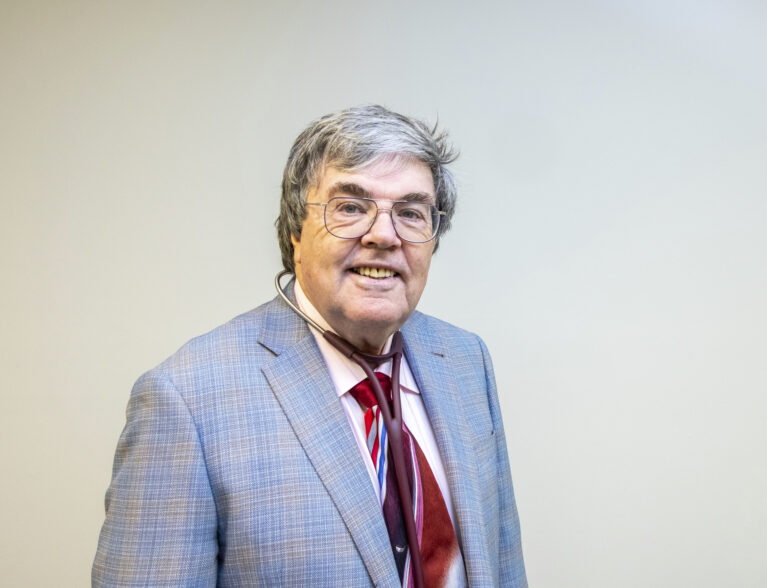
Artificial Intelligence (AI), once the realm of science fiction, has become an integral part of everyday life and medical care. It powers instant Internet searches, drafts business plans, predicts stock market trends, assists self-driving cars, composes music and books, and accelerates medical research. With AI evolving at an astonishing pace, experts believe it could eventually surpass human intelligence in some fields.
One such groundbreaking advancement is being developed right here on the Treasure Coast, where a local cardiologist is testing AI’s ability to detect clogged arteries by analyzing the sound waves captured by a stethoscope.
Dr. Thomas Haffey, a board-certified clinical cardiologist in Vero Beach, is working on a concept of using the sound waves from the carotid artery to determine whether or not a patient has hardening of the arteries or atherosclerosis in the carotid arteries.
“We acquire the sound and put it through an artificial intelligence engine, and we can tell if there are blockages there or not. We are in the process of trying to establish whether we can quantify them specifically, non-invasively and very cost effectively. We had a poster presentation at the World Congress of Cardiology at the American College of Cardiology meeting in New Orleans in 2023 and we’re continuing our research with the hope of having a product in the next couple of years,” he said.
Dr. Haffey envisions a device that requires very little training to use that could get immediate results just from the sound waves generated by blood flow.
“It would take about five minutes to show a clinician how to use it,” he said. “You put the device on somebody’s neck and in the middle of sub-Saharan Africa you could get on the Internet and send the info to an AI engine and it could tell you whether there’s stenosis and whether or not you need intervention or whether or not you need some change in your medication to prevent any progression.”
Dr. Haffey became interested in this concept about a decade ago when he had a patient who was going for open heart surgery. The standard approach to someone with carotid atherosclerosis, which can lead to a stroke or transient ischemic attack, is to put a stethoscope on their neck and listen for an abnormal sound called a bruit. A bruit is the sound of turbulent blood flow in one or more of your carotid arteries.
“Think of it as a river flowing with the blood being the water in the river,” explained Dr. Haffey.
“If you have atherosclerosis, then imagine that there are rocks in the river that create turbulence and the turbulence creates sound. Unfortunately, our current stethoscopes are too large, and the human ear is not able to discern some of the sounds that can be picked up with artificial intelligence acquisition.
“We’ve designed a stethoscope that is about 1/10th the size of the current stethoscopes and capable of getting multiple acoustic windows on the carotid. Those sounds are recorded and put into an electronic medical record, making it easy to share with other professionals anywhere in the world,” he said.
“One of the problems with relying on a clinician listening to a carotid artery is the reliance on that person’s listening and their description of what they hear. There is no permanent record, so sharing that information with the rest of the medical community has been a challenge. Our goal is to overcome these hurdles by having a device that’s very easy to use, that is recordable, reproducible and sharable so that you can do arterial examinations and compare and see if the current medical therapy that the patient is on is being successful in eliminating the progression of atherosclerosis.”
After preliminary studies of 24 patients, there was a more significant study of about 140 patients. The results of that study were presented at the World Congress of Cardiology at the American College of Cardiology. Currently there are three sites acquiring more data.
“One of the challenges of AI is that is very data-hungry,” Dr. Haffey confided. “You have to feed a lot of data for it to give you information. We are now in the process of [doing additional studies] to satisfy the AI beast. We are in the final stages of providing that data so that it can become commercially available in the near future. At this point, with the preliminary studies, we can give a 95 percent to 98 percent predictability telling you that you do or don’t have anything to worry about.”
Dr. Haffey came up with the idea to utilize AI for the detection of heart disease in the middle of night but realized that an idea is nothing unless you can prove it is valid, so he teamed up with Bongiovi Acoustics in Port St. Lucie for technical development of the new device.
“The original founder of Bongiovi Acoustics was the cousin of the rock ’n’ roll legend by the same name [Jon Bon Jovi],” Dr. Haffey said. “The initial part of the company came out of the acoustic rock ’n’ roll studios. So it is a marriage of their expertise and genius in the field of acoustic recording and my passion for trying to translate that acoustic research into a practical application to save lives and keep people out of the hospital.
“The human ear is simply not capable of discerning the sounds of carotid and clinicians don’t have great expertise in listening. Currently if they suspect something and think you might have atherosclerosis, then they order an ultrasound, which can cost anywhere from $400 to $1,200.
With our device this can be done much more cost effectively. You don’t need expensive equipment, and we are not putting anything into the body. We are just listening to the natural sounds of the artery and from those sounds we can make clinical decisions.”
In order to get FDA approval, it generally takes six to 10 years and Dr. Haffey estimates that his device is about halfway through the process.
Dr. Thomas Haffey, D.O., is board certified in internal medicine, cardiology and lipidology, which is the study of cholesterol. He is a nationally recognized speaker at national and international symposiums, with presentations in 45 states and six foreign countries. He practiced cardiology in Denver for 40 years before moving to Florida.



